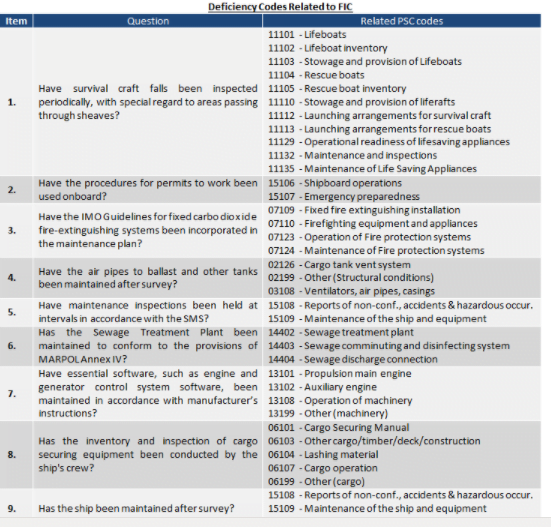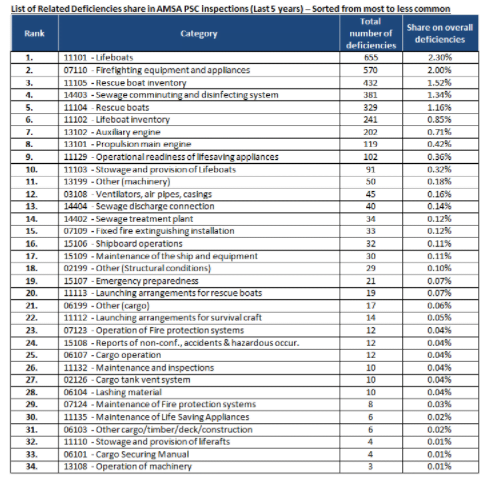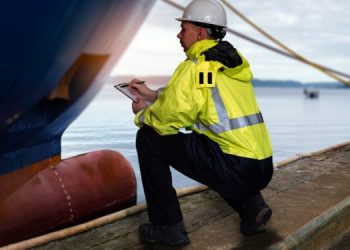SQE MARINE consulting firm has issued circular to provide guidance to ship operators on Focused Inspection Campaign (FIC) on Planned Maintenance.
Overview
AMSA has issued Marine Notice 9/2021 to announce that a Focused Inspection Campaign (FIC) on Planned Maintenance will be conducted from 15 January 2022 to 30 March 2022. AMSA surveyors will undertake the FIC in conjunction with a normal port or flag State control inspection. Any port State control deficiencies will be reported to regional port State control databases.
Aim of FIC
The purpose of the FIC is to determine the level of compliance with the maintenance requirements of the International Conventions.
Questionnaire
AMSA PSCOs will be using a checklist (Appendix A) when inspecting ships as part of the planned maintenance FIC.
Actions required
Ship managers should be prepared to address related FICs items. Planned maintenance is an important aspect when considering seaworthiness.
How we may help
SQEMARINE can provide guidance for FIC questionnaire with a best practice guide (Appendix B) and an analysis on AMSA findings per Deficiency Category, based on data from RiSK4SEA platform (Appendix C)
Page Break
Appendix A
Focused Inspection Campaign Questionnaire (as per Marine Notice 9/2021)
Appendix B
Best Practice Guidance on FIC Questionnaire
#1 Have survival craft falls been inspected periodically, with special regard to areas passing through sheaves?
SOLAS Maintenance plan on board to be followed. Lifeboats supporting systems to be inspected as required. Details for wires and load tests to be available. As the PSCO will not only check the falls and the dynamic tests, ALL survival systems should be as required in accordance with SOLAS and the inspections on survival equipment should be conducted: weekly, monthly, annually, every five years.
Weekly:
- inspection of all survival craft, rescue boats and launching appliances to ensure that they are ready for use
- inspection of the condition of hooks and their attachment to the lifeboat
- inspection to ensure the on-load release gear is properly and completely reset
- lifeboat and rescue boats engine shall be run for a total period of not less than 3 minutes
- it should be demonstrated that the gearbox and gearbox train are engaging satisfactorily
- a report of the tests and inspections shall be entered in the Log Book or the Planned Maintenance System.
Monthly:
- All lifeboats, except free-fall lifeboats should be turned out from their stowed position, without any persons onboard, if weather and sea conditions so allow.
- Inspection of the life-saving appliances, including lifeboat equipment, should be carried out, using the checklist required by SOLAS Regulation 36.1, to ensure that they are complete and in good order.
- A report of the inspection must be entered in the Log Book or Planned Maintenance System
Annually
An annual inspection and maintenance by a service agent approved in accordance with the requirements of the ship’s Flag State.
Davits
- Inspection of davit structure, falls and sheaves
- lubrication of davit wires, sheaves and moving parts
- function check of davit limit switches.
Lifeboat
- Condition of lifeboat structure including fixed and loose equipment
- engine propulsion systems
- sprinkler and air supply systems, if fitted
- manoeuvring system
- stored power system (batteries and hydraulic starter units)
- hydraulic systems.
Winch and brake
- Dynamic test of winch brake at maximum lowering speed
- inspection of brake mechanism
- remote control system (remote brake release)
- winch power supply system
- winch foundation.
Release gear
- Dismantling of hook release units
- examination with regard to tolerances and design requirements
- adjustment of release gear after assembly
- examination of vital parts with regard to defects and cracks
- hydrostatic interlock system, where fitted
- cables for control and release
- hook fastening
- operational test of on-load and off-load release gear.
Inflatable liferafts and inflatable lifejackets
- Shall be serviced by an approved service station at intervals not exceeding 12 months.
Hydrostatic release units
- Shall be serviced by an approved service station at intervals not exceeding 12 months unless single use, fixed life units are fitted, in which case they should be changed at the designated time.
Every 5 Years
- Falls used in launching shall be inspected periodically, with special regard for areas passing through sheaves, and renewed when necessary due to deterioration of the falls or at intervals of not more than 5 years, whichever is the earlier.
- In addition to the annual inspection and service requirements, at intervals not exceeding 5 years, a dynamic test of launching appliances and on-load release gear shall be carried out with a proof load equal to 1.1 times the weight of the survival craft and its full complement of persons and equipment. Water sacks or sandbags are commonly used for this purpose.
#2 Have the procedures for permits to work been used onboard?
SMS should include a section with high risk tasks / operations which should be covered from an effective permit to work system. The permit to work system should include authorization level (who authorizes the task or operation), initial conditions (which determine if it is safe to conduct the task/operation), risk assessment review for the specific task/operations, time frame of permit, periodical checks on initial conditions status.
A stop work Authority maybe part of permit to work system. A more advanced system may include provisions for simultaneously conducted operations (SIMOPS).
Most common tasks on board which could be covered by a typical permit to work system are:
- Enclose space entry
- Hot / Cold works
- Working aloft (or over side)
- Launching LSA
- Electrical work
#3 Have the IMO Guidelines for fixed carbo dioxide fire-extinguishing systems been incorporated in the maintenance plan?
Fixed carbon dioxide fire-extinguishing systems should be kept in good working order and readily available for immediate use. Maintenance and inspections should be carried out in accordance with the ship’s maintenance plan having due regard to ensuring the reliability of the system. As per IMO guidance the following actions are required:
Monthly inspections
- all stop valves are in the closed position;
- all releasing controls are in the proper position and readily accessible for immediate use;
- all discharge piping and pneumatic tubing is intact and has not been damaged;
- all high pressure cylinders are in place and properly secured;
- the alarm devices are in place and do not appear damaged.
- the pressure gauge is reading in the normal range;
- the liquid level indicator is reading within the proper level;
- the manually operated storage tank main service valve is secured in the open position;
- the vapour supply line valve is secured in the open position
Annual Inspections
- the boundaries of the protected space should be visually inspected to confirm that no modifications have been made to the enclosure that have created not closeable openings that would render the system ineffective;
- all storage containers should be visually inspected for any signs of damage, rust or loose mounting hardware. Cylinders that are leaking, corroded, dented or bulging should be hydrostatically retested or replaced;
- system piping should be visually inspected to check for damage, loose supports and corrosion. Nozzles should be inspected to ensure they have not been obstructed by the storage of spare parts or a new installation of structure or machinery;
- the manifold should be inspected to verify that all flexible discharge hoses and fittings are properly tightened;
- all entrance doors to the protected space should close properly and have warning signs, which indicate that the space is protected by a fixed carbon dioxide system and that personnel should evacuate immediately if the alarms sound. All remote releasing controls should be checked for clear operating instructions and indication as to the space served.
Further maintenance and tests are required (every 2 years for passenger ships or at each intermediate, periodical or renewal survey in cargo ships
#4 Have the air pipes to ballast and other tanks been maintained after survey?
An air pipe prevents overpressure or vacuum in the tank when liquid is pumped in or out. When air pipes become obstructed from wear and tear after a period in operation, maintaining the required air flow through the pipe may no longer be possible – and an important prerequisite for maintaining the tank’s structural integrity during filling operations may no longer be fulfilled. For the same reason, it is also a general requirement that air pipes shall not be fitted with valves that may impair the venting function.
- Regular inspections of air vents and closing devices should be carried out to identify operational condition (e.g. visible rust signs, dirt or damages etc.);
- Particular attention should be paid to air pipes located in the fore deck due to their exposure depending on the ship’s movements and the impact from heavy seas;
- During tank inspections, the automatic closing devices should be dismantled and opened up at regular time intervals for a more detailed inspection;
- The malfunctioning air pipe automatic closing devices should be replaced only with devices of an approved type (e.g. classification society etc.)
#5 Have maintenance inspections been held at intervals in accordance with the SMS?
Safety Management System in order to address ISM clause 10 Maintenance of the Ship and Equipment, should include:
- appropriate inspections intervals,
- any non-conformity is reported with its possible cause, if known,
- appropriate corrective action is taken,
- records of these activities are maintained.
Records of inspections/defects/follow up reports should be maintained and be ready for inspection from the PSCO.
#6 Has the Sewage Treatment Plant been maintained to conform to the provisions of MARPOL Annex IV?
Always follow IMO Resolution MEPC.227(64). For each Sewage Treatment plant routine maintenance of the system should be clearly defined by the manufacturer in the associated operating and maintenance manuals. All routine and repair maintenance should be recorded.
Provided documentation for maintenance should include:
- Operational details (start/stop)
- Inspections details (intervals and spare parts)
- chemicals and other materials actually utilized in the operation
- clean-up of the plant
Engine Crew should be familiar with the sewage treatment plant operation and cleaning procedures. Any malfunction or non-compliance (e.g. broken or missing equipment etc.) should be reported immediately to the vessel’s Flag Administration and a Letter of Extension to be issued, in order to avoid unpleasant delays from Port State Control Officers.
#7 Have essential software, such as engine and generator control system software, been maintained in accordance with manufacturer’s instructions?
Monitoring and control of the ships propulsion and power is essential for its efficiency and safety and there are many systems and parameters to consider like: fuel consumption, combustion temperature, engine temperature, diesel engine safety and start/stop, generator voltage and frequency control, generator load in KW and %, load control, torque, heavy consumers logic, control of diesel electric propulsion, thrusters monitoring and control etc. All the above may be monitored and controlled by a digital control system operating through a software as per system manufacturer. This software requires checks and updates as per manufacturers’ guidance. The maintenance and updates should be conducted by a qualified individual/technician. Additionally specific cyber security control measures should be in place in order to protect the system from software breach, as per IMO requirements for cyber security procedures.
#8 Has the inventory and inspection of cargo securing equipment been conducted by the ship’s crew?
Vessels covered by cargo securing manual should have a proper inventory and inspection report for securing devices, apart from the inventory maintenance records for these specific equipment/devices. Securing devices not belonging to the vessel must not be used as they may not conform to the vessels Cargo Securing Manual. Defective securing devices shall as far as possible be repaired on board and if not possible then these shall be condemned. Shortfall of cargo securing devices shall be reported through the inventory and inspection report and requisition raised to address the shortfall.
#9 Has the ship been maintained after survey?
As per IMO, all ships must be surveyed and verified by officers of the flag State Administrations or their recognized organizations (ROs)/recognized security organizations (RSOs)/nominated surveyors so that relevant certificates can be issued to establish that the ships are designed, constructed, maintained and managed in compliance with the requirements of IMO Conventions, Codes and other instruments.
Periodical surveys:
- Annual survey. It is aimed at establishing that the ship sufficiently meets the conditions of class retainment, as well as to check the operation of mechanisms, devices and installations, to which the requirements of the Rules for the Classification and Construction of Sea-Going Ships are applied.
- Intermediate survey. It includes checking of hull structures, machinery, boilers and pressure vessels, equipment and supplies, electrical equipment to ensure that they remain in good condition for the type of ship operation, for which they are intended. Intermediate survey shall be conducted during or between the second and third annual surveys.
- Special survey. It is conducted for the renewal of the class and aimed at establishing that the technical condition of the ship and changes in the composition and design of its facilities meet the requirements of the Rules. Special survey is conducted at intervals that do not exceed 5 years, with the renewal of the class, as a rule, for the next five-year period.
Ship managers should have an efficient maintenance program to cover the maintenance requirements of their managed ships during the time periods between the surveys. In fact, surveys from Classification society should verify the good maintenance conducted by the manager.
Appendix C
AMSA Deficiencies on FIC Items (Last 5 Years)
(Source RiSK4SEA)




































































